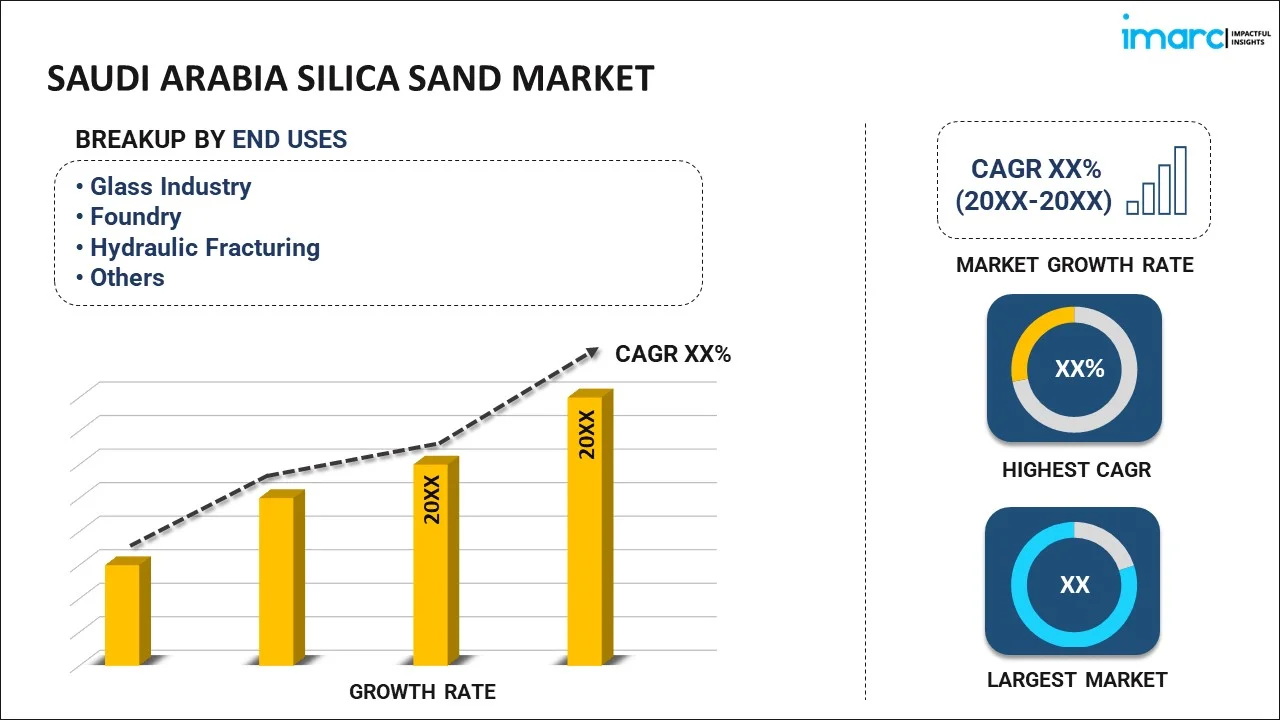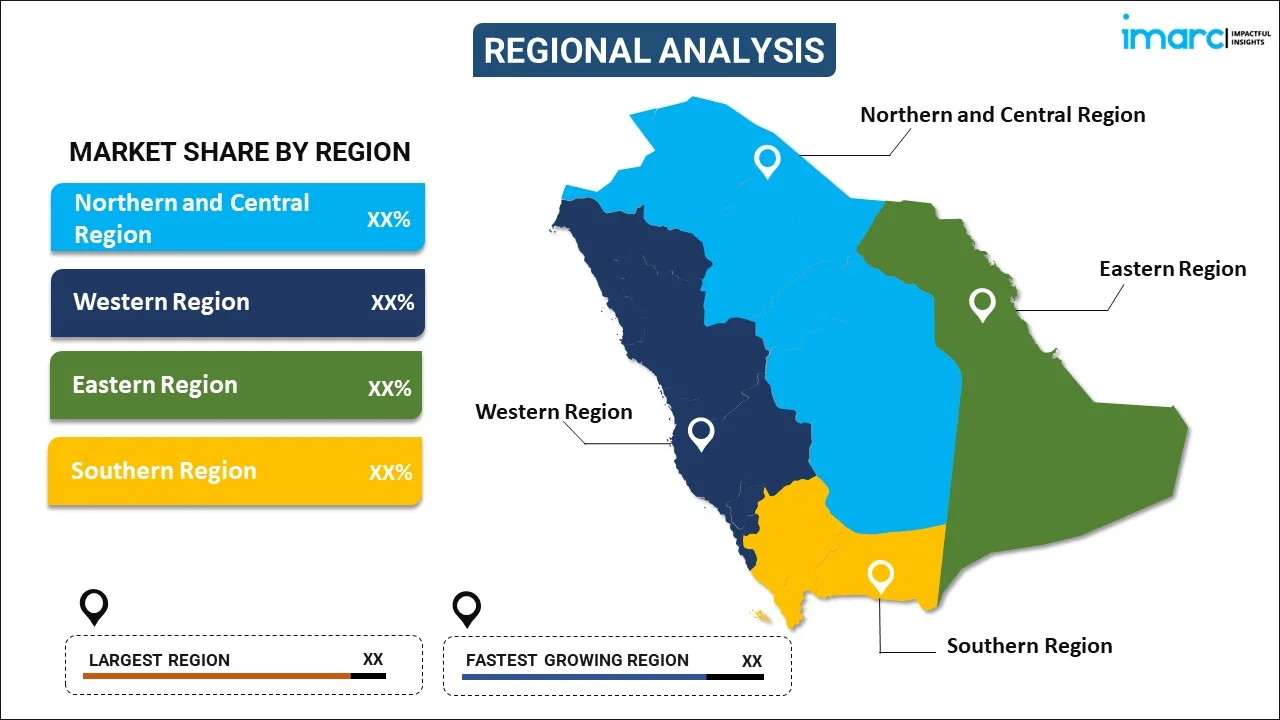
Saudi Arabia Silica Sand Market Report by End Use (Glass Industry, Foundry, Hydraulic Fracturing, Filtration, Abrasives, and Others), and Region 2025-2033
Market Overview:
Saudi Arabia silica sand market size is projected to exhibit a growth rate (CAGR) of 5.89% during 2025-2033. The expanding production capacities and the rising emphasis of key players on developing high-purity silica sand for specialized glass manufacturing processes are primarily propelling the market growth across the country.
|
Report Attribute
|
Key Statistics
|
|---|---|
|
Base Year
|
2024 |
|
Forecast Years
|
2025-2033
|
|
Historical Years
|
2019-2024
|
| Market Growth Rate (2025-2033) | 5.89% |
Silica sand, also referred to as industrial sand, mainly consists of quartz, along with other substances or organic materials, including feldspars, carbonates, iron oxides, micas, clay minerals, coal, etc. Typically found as loose deposits beneath thin soil layers or as part of sandstone, it is obtained from both unbound sand deposits and by crushing softly cemented sandstones. Characterized by its high melting point, minimal thermal expansion, and increased chemical resilience, silica sand is a highly sought-after material for diverse uses. It is widely adopted in glass manufacturing, due to its purity and uniformity. Silica sand is essential in creating specialized glasses used in solar panels, fiber optics, and scientific glassware. In the construction sector, it is a fundamental ingredient in concrete, mortar, and similar cement-based products. Additionally, its use as a proppant in hydraulic fracturing processes for improving oil and gas extraction from subterranean rock formations is elevating its demand in the country.
Saudi Arabia Silica Sand Market Trends:
The Saudi Arabia silica sand market is primarily driven by the expanding construction sector and the increasing demand for glass products across the country. Moreover, the growing investments in infrastructure development projects are augmenting the adoption of high-quality silica sand. Additionally, the rising automotive industry in the country, which requires specialized glass products, is acting as another significant growth-inducing factor. Besides this, the easy availability of product variants in Saudi Arabia, along with the increasing focus of government bodies to diversify the economy, is also bolstering the market growth. Emerging trends in the Saudi Arabia silica sand market include the growing emphasis on sustainable mining practices. Apart from this, the elevating consumer awareness towards the environmental impact of silica sand mining is leading to the implementation of stringent regulations by government bodies across the country. Moreover, technological advancements in silica sand processing to enhance the quality and reduce the environmental footprint of production processes are expected to fuel the market growth in Saudi Arabia over the forecasted period.
Saudi Arabia Silica Sand Market Segmentation:
IMARC Group provides an analysis of the key trends in each segment of the market, along with forecasts at the country level for 2025-2033. Our report has categorized the market based on end use.
End Use Insights:

- Glass Industry
- Foundry
- Hydraulic Fracturing
- Filtration
- Abrasives
- Others
The report has provided a detailed breakup and analysis of the market based on the end use. This includes glass industry, foundry, hydraulic fracturing, filtration, abrasives, and others.
Regional Insights:

- Northern and Central Region
- Western Region
- Eastern Region
- Southern Region
The report has also provided a comprehensive analysis of all the major regional markets, which include Northern and Central Region, Western Region, Eastern Region, and Southern Region.
Competitive Landscape:
The market research report has also provided a comprehensive analysis of the competitive landscape in the market. Competitive analysis such as market structure, key player positioning, top winning strategies, competitive dashboard, and company evaluation quadrant has been covered in the report. Also, detailed profiles of all major companies have been provided.
Saudi Arabia Silica Sand Market Report Coverage:
| Report Features | Details |
|---|---|
| Base Year of the Analysis | 2024 |
| Historical Period | 2019-2024 |
| Forecast Period | 2025-2033 |
| Units | Million USD |
| Scope of the Report | Exploration of Historical Trends and Market Outlook, Industry Catalysts and Challenges, Segment-Wise Historical and Future Market Assessment:
|
| End Uses Covered | Glass Industry, Foundry, Hydraulic Fracturing, Filtration, Abrasives, Others |
| Regions Covered | Northern and Central Region, Western Region, Eastern Region, Southern Region |
| Customization Scope | 10% Free Customization |
| Post-Sale Analyst Support | 10-12 Weeks |
| Delivery Format | PDF and Excel through Email (We can also provide the editable version of the report in PPT/Word format on special request) |
Key Questions Answered in This Report:
- How has the Saudi Arabia silica sand market performed so far and how will it perform in the coming years?
- What has been the impact of COVID-19 on the Saudi Arabia silica sand market?
- What is the breakup of the Saudi Arabia silica sand market on the basis of end use?
- What are the various stages in the value chain of the Saudi Arabia silica sand market?
- What are the key driving factors and challenges in the Saudi Arabia silica sand?
- What is the structure of the Saudi Arabia silica sand market and who are the key players?
- What is the degree of competition in the Saudi Arabia silica sand market?
Key Benefits for Stakeholders:
- IMARC’s industry report offers a comprehensive quantitative analysis of various market segments, historical and current market trends, market forecasts, and dynamics of the Saudi Arabia silica sand market from 2019-2033.
- The research report provides the latest information on the market drivers, challenges, and opportunities in the Saudi Arabia silica sand market.
- Porter's five forces analysis assist stakeholders in assessing the impact of new entrants, competitive rivalry, supplier power, buyer power, and the threat of substitution. It helps stakeholders to analyze the level of competition within the Saudi Arabia silica sand industry and its attractiveness.
- Competitive landscape allows stakeholders to understand their competitive environment and provides an insight into the current positions of key players in the market.
Need more help?
- Speak to our experienced analysts for insights on the current market scenarios.
- Include additional segments and countries to customize the report as per your requirement.
- Gain an unparalleled competitive advantage in your domain by understanding how to utilize the report and positively impacting your operations and revenue.
- For further assistance, please connect with our analysts.
 Inquire Before Buying
Inquire Before Buying
 Speak to an Analyst
Speak to an Analyst
 Request Brochure
Request Brochure
 Request Customization
Request Customization




.webp)




.webp)












